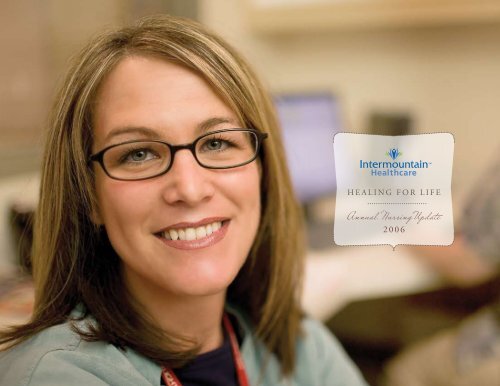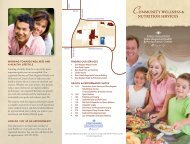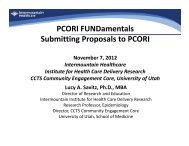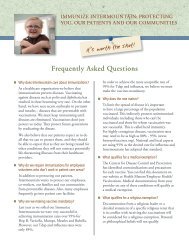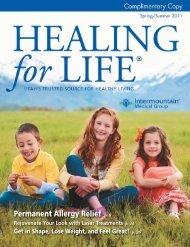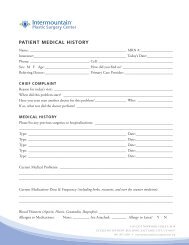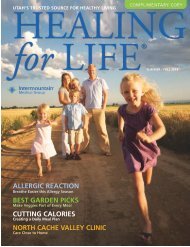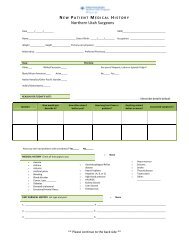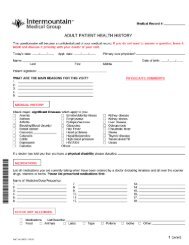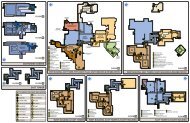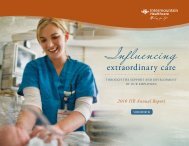Annual Nursing Update - Intermountain Healthcare
Annual Nursing Update - Intermountain Healthcare
Annual Nursing Update - Intermountain Healthcare
- No tags were found...
You also want an ePaper? Increase the reach of your titles
YUMPU automatically turns print PDFs into web optimized ePapers that Google loves.
<strong>Nursing</strong> is a remarkable combinationof science and art;knowledge and clinical competenciesand a desire to comfort, listen, care,and help heal to the best of our abilities — it’s botha profession and a passion.Our caring for the patient and our caring about the patientare both part of every interactionas we aspire to provide extraordinary carein all its dimensions.
ta b l e o f c o n t e n t sl e t t e r f r o m c h i e f n u r s i n g o f f i c e r .. . . . . . . . . . . . . . . . . . . . . . . . . . 2o u r n u r s i n g p h i l o s o p H y .. . . . . . . . . . . . . . . . . . . . . . . . . . . . . . . . . . . . . . . . . . . . . 5o u r h e a l i n g c o m m i t m e n t s .. . . . . . . . . . . . . . . . . . . . . . . . . . . . . . . . . . . . . . . . . 62 0 0 6 N U R S I N G a c c o m p l i s h m e n t s .. . . . . . . . . . . . . . . . . . . . . . . . . . . . . . . . . . 7o u r m a g n e t r e c o g n i t i o n j o u r n e y .. . . . . . . . . . . . . . . . . . . . . . . . . . . 1 3n u r s i n g h i g h l i g h t s , b y r e g i o n . . . . . . . . . . . . . . . . . . . . . . . . . . . . . . . . 1 5n u r s i n g h i g h l i g h t s , b y c l i n i c a l p r o g r a m .. . . . . . . . . . . . . . 3 3n u r s i n g r e s e a r c h p r o j e c t s & g r a n t s . . . . . . . . . . . . . . . . . . . . . . . 4 5n u r s i n g s tat i s t i c s .. . . . . . . . . . . . . . . . . . . . . . . . . . . . . . . . . . . . . . . . . . . . . . . . . . . . . . 4 8n u r s I N G e x c e l l e n c e AWA R D E E S . . . . . . . . . . . . . . . . . . . . . . . . . . . . . . . . . . . 5 2
Dear Team,Each year, <strong>Nursing</strong> at <strong>Intermountain</strong> <strong>Healthcare</strong> continues to grow and thrive. With our StrategicPlan as the foundation of our <strong>Nursing</strong> goals, I continue to be amazed at all you accomplish.In 2006, we continued our Magnet journey, nurtured our relationships with the nursing collegesstatewide, engaged in nursing research projects that have helped strengthen our practice and, ofcourse, have actively participated in making the <strong>Intermountain</strong> Healing Commitments come alive.<strong>Nursing</strong> is key in reaching our aspiration of Extraordinary Care. As nurses, our ability to care forand about our patients is the hallmark of our practice. Our technical skills, along with caring andcompassion, help us provide excellence in quality and service.Photo by Adam FinkleIn 2007, we are launching Healing Connections. This is the tool we will use to implement ourHealing Commitments through an interdisciplinary approach that includes education and trainingfor all clinical staff and administrative leadership.It is my privilege to lead the Council of Chief <strong>Nursing</strong> Officers and help support our professionsystemwide. Thanks to each of you for your dedication to our patients, their loved ones, and eachother. Thank you for providing healing for life.N a n c y A . N owa k , R N , M AVice President of Clinical Operations, Chief <strong>Nursing</strong> Officer. . . 2 . . .
<strong>Nursing</strong> P hilosophyO u r N u r s i n g P h i l o s o p h ya n d H e a l i n g C o m m i t m e n t s<strong>Intermountain</strong> <strong>Healthcare</strong><strong>Nursing</strong> VisionAdvancing the art and science of professional nursing and providingextraordinary care through strategic leadership,innovative care delivery systems, and evidence-based nursing practice.<strong>Nursing</strong> at <strong>Intermountain</strong> <strong>Healthcare</strong> is a dynamic profession based onapplied science. The discipline of nursing has a solid theoretical basethat drives nursing practice and research. Nurses are part of the interdisciplinaryhealthcare team. They provide holistic care in partnershipwith patients to meet their needs across the continuum, includinghospitals, Homecare, clinics, and SelectHealth.At <strong>Intermountain</strong>, the concept of CARING is the foundation ofour practice. We define caring through Collaboration, Accountability,Research-based practice, Innovation, <strong>Nursing</strong> leadership, and Growth.ollaboration – is seen in our relationships with other nurses, clinicians, patients,and families. <strong>Nursing</strong> shares knowledge of medicine, and has its own distinctivetheory, specialized practice, social contract, ethical code, and body of knowledge.Nurses, as coordinators of patient care, are successful through their expertise as theycollaborate with other healthcare disciplines. These relationships support each otheras colleagues foster excellence in patient care.ccountability – is the cornerstone of professional nursing at <strong>Intermountain</strong>. Weevaluate our practice through outcome measures and continually strive to improveorganizational processes and individual efforts. Each nurse owns his or her individualpractice and is accountable to continually work to advance the nursing profession.esearch-based practice – guides our care. The nursing process is the foundationby which we develop standards of practice and professional performance. Researchis an indispensable tool for nursing practice. It supports meaningful change andfosters innovation.nnovation – is driven and celebrated throughout all levels of the nursing organization.Nurses are frontline change agents and leaders in practice and processimprovement. We are committed to investigating, developing, implementing, andevaluating new models of care and practice innovation to keep nursing vibrantwithin our organization. <strong>Intermountain</strong> partners with institutions of higher learningto support education and continually evaluate and elevate the practice of nursing.ursing leadership – is strong and present at all levels. Nurses play an integral part inhelping set policy and in making decisions that affect patient care. <strong>Nursing</strong> leadershipis key at the department, hospital, and organizational level, and within our medicalstaff and trustees. The role of the staff nurse as a leader is woven into the fabric of theorganization, and is supported through formal and informal leadership development.rowth – is our goal individually and as stewards of our profession. At <strong>Intermountain</strong>,<strong>Nursing</strong> is committed to individual competence and life-long learning. RegisteredNurses can focus their practice in management, education, or clinical expertise. Thisprogression model allows for individual career advancement, assuring a high levelof job satisfaction and loyalty among nurses committed to <strong>Intermountain</strong>’s Mission,Vision, and Values.. . . 5 . . .
As an <strong>Intermountain</strong> <strong>Healthcare</strong> employee,Healing CommitmentsI am committed to creating anI keep you informed and involved.I ensure our team works with you.. . . 6 . . .extraordinary experience for those I serve.I help you feel safe, welcome, and at ease.I listen to you with sensitivity and respond to your needs.I treat you with respect and compassion.I take responsibility to help solve problems.
I n t e r m o u n ta i n ’ s 2 0 0 6<strong>Nursing</strong> AccomplishmentsWhen a nurse walks into a room, healing begins. When in need of medical attention and care,we all take comfort knowing a nurse is there — whether it’s from a gentle smile or skill in performinga procedure. Nurses are at the heart of healthcare; they are a critical part of the healthcareteam. At <strong>Intermountain</strong>, the Council of Chief <strong>Nursing</strong> Officers provides direction in creating anenvironment of participatory nursing. By working with this Council, our <strong>Nursing</strong> Leadership,<strong>Nursing</strong> Education, <strong>Nursing</strong> Research, and <strong>Nursing</strong> Practice Councils are able to involve nurses atevery level and position in <strong>Intermountain</strong>.Because of this, our accomplishments support <strong>Intermountain</strong>’s mission for clinical excellencesystemwide. The following is a brief summary of major accomplishments in <strong>Nursing</strong> in 2006.They capture our commitment to <strong>Intermountain</strong>’s mission and vision, and demonstrate our progressas we strive to provide extraordinary care in all its dimensions.K a r e n K i n g , R N , M S N , M A , C N A A , B CAssistant Vice President of <strong>Nursing</strong>, Clinical Operations. . . 7 . . .
n u r s I N G p r o c e s s i m p r o v e m e n tWorkgroupsThe Council of Chief <strong>Nursing</strong> Officers wanted to pilot specific solutions to patient dissatisfiersidentified at the <strong>Nursing</strong> Leadership Summit in February 2006. A team of Nurse Managersled three workgroups in researching national and local best practices, understanding our currentstate, and developing recommendations for improving nursing processes in the areas of handoffs,engagement, and outcomes.Recommendations from the workgroups included: piloting primary and secondary handoff tools,implementing a process to emphasize employee/patient engagement and encourage managerrounding (Healing Connections), and developing patient orientation materials. This will includea patient orientation video; the outcomes workgroup believes that addressing basic patientorientation needs will provide nurses with more time to help patients set daily goals focused onclinical outcomes.. . . 8 . . .
C o l l a b o r at i v e P r a c t i c eGuidelines8,0007,0006,000Collaborative Practice Guidelines (CPG) support <strong>Intermountain</strong>’sphilosophy of best practice and promote the delivery of quality5,000clinical care through consistent, evidence-based practice. They4,000are established using: national standards; <strong>Intermountain</strong>’s existingguidelines, protocols, procedures, and Clinical Program Care3,000Process Models; and literature that supports an evidence-based2,000philosophy. The guidelines are written for general use, with theunderstanding and expectation that they can be modified based1,000on patient need and as new information becomes available withscientific advances. In 2006, we saw continued growth in CPGviewer usage (please see chart).0JUN 04AUG 04OCT 04DEC 04FEB 05APR 05JUN 05AUG 05OCT 05DEC O5FEB 06APR 06JUN 06AUG 06OCT 06DEC 06USERSSESSIONS. . . 9 . . .
e d u c at i o n a l pa rt n e r s h i p sMagnet<strong>Intermountain</strong> <strong>Healthcare</strong> gave a $3 million gift to the University ofUtah’s College of <strong>Nursing</strong> for the renovation of the nursing building andcreation of a new Simulation Center. The Center will be more than doubleits current size and will develop students’ clinical and decision-makingskills in realistic patient-care scenarios.<strong>Intermountain</strong> also donated $3 million to help Salt Lake CommunityCollege complete construction on a new Health Sciences Center. The newfacility is critical to ensuring that Utah continues to have highly qualifiedclinical professionals to serve the needs of future patients.These donations were part of a series of donations given to nine Utahnursing schools in 2005 and 2006.N u r s i n g G o a l s f o r 2 0 0 7• Collaborate with Clinical Programs to reach CMS/Joint CommissionCore Measures Goals and Clinical Program Board goals• Begin implementing Healing Connections to support ourHealing Commitments and improve patient satisfaction• Implement the recommendations of our <strong>Nursing</strong> ProcessImprovement Teams• Analyze the Nurse Manager role and implement changes whichincrease time on the unit, focused on our Dimensions of CareMagnet status is the highest designation of the American Nurses CredentialingCenter (ANCC), a subsidiary of the American Nurses Association. Magnetdesignation recognizes healthcare facilities for excellence in nursing. The fourteen“Forces of Magnetism” that compose Magnet designation are validation of anexcellent work environment — and assurance that a superior environment will beongoing. Magnet facilities demonstrate excellence by providing the very best innursing care, demonstrating leadership in advancing and improving patientsafety measures, and promoting professional growth.In October 2006, the Urban Central Region submitted an Interim Reportto the ANCC, and will submit another in October 2007. This is the firstof many steps as they work toward redesignation in 2009. <strong>Intermountain</strong>’sother hospitals are continuing along their Magnet journey as well; the CentralMagnet Steering Team continued to close “gaps” identified in the System GapAnalysis conducted in 2004. Seven gaps were closed in 2006, including:• Developing a peer review process for bedside clinical staff• Encouraging individual nurses to develop a professional portfolioto capture the wealth and depth of their accomplishments forcareer planning• Defining an educational plan for staff around cultural diversityand cultural competencies.Additionally, in preparation for site visits by Magnet appraisers, members ofthe Steering Team developed “mock site visits” in which facilities are evaluatedas if a Magnet appraiser were present. These visits are designed for hospitalsseeking certification within 12-18 months. These mock site visits closely followthe method and strategies used by Magnet appraisers, and allow nurses anopportunity to demonstrate why their facility is worthy of Magnet designation.. . . 1 1 . . .
Magnet TodayMagnet designation is so named because credentialed hospitals attract andretain top nursing professionals, which is key to providing consistentlyhigh-quality care. Independent research has shown that hospitals earningMagnet status have higher patient satisfaction, better clinical outcomes,lower mortality rates, higher job satisfaction for nurses, lower rates of nurseburnout, and increased nurse retention and recruitment rates. Out of the6,000 U.S. hospitals, about 200 have achieved Magnet status.T h e M a g n e t P r o c e s s• Make the commitment• Meet the eligibility criteria• Become educated and spread the word• Do a Gap Analysis• Apply• Collect and submit written documentation• Host a site visitT h e F o r c e s o f M a g n e t i s mOrganizational Elements Of Excellence In <strong>Nursing</strong> Care:1. Quality of nursing leadership – <strong>Nursing</strong> leaders are knowledgeable,strong risk-takers who follow an articulated philosophyin the day-to-day operations of the department. <strong>Nursing</strong> leadersalso convey a strong sense of advocacy and support on behalfof the staff.2. Organizational structure – Organizational structures are characterizedas flat, rather than tall, and by unit-based decision-making.<strong>Nursing</strong> departments are decentralized, with strong nursingrepresentation in the organizational committee structure. Thenursing leader serves at the executive level of the organization.3. Management style – Hospital and nursing administrators useparticipative management style, incorporating feedback from staffat all levels of the organization. Feedback is encouraged andvalued. <strong>Nursing</strong> leaders are visible, accessible, and committed toeffective communication.4. Personnel policies and programs – Salaries and benefits arecompetitive. Rotating shifts are minimized, and creative andflexible staffing models are used. Personnel policies are createdwith staff involvement, and significant administrative and clinicalpromotional opportunities exist.5. Professional models of care – Models of care give nurses theresponsibility and authority for the provision of patient care. Nursesare accountable for their practice and are coordinators of care.6. Quality of care – Nurses provide high-quality care to patients.Providing quality care is an organizational priority and nursingleaders are responsible for developing an environment wherehigh-quality care can be provided.7. Quality improvement – Quality improvement is educational. Staffnurses embrace improvement processes as means to increase thequality of care delivered.8. Consultation and resources – Adequate consultation and otherhuman resources are available. Knowledgeable experts, particularlyadvanced-practice nurses, are available and utilized. In addition,peer support is given inside and outside the nursing division.9. Autonomy – Nurses are permitted and expected to practice autonomously,consistent with professional standards. Independent judgmentis exercised within the context of a multidisciplinary approach to care.. . . 1 2 . . .
10. Community and the hospital – Hospitals that are best able torecruit and retain nurses also maintain a strong community presence.A community presence is seen in a variety of ongoing, long-termoutreach programs. These outreach programs show that a hospitalis a strong, positive, and productive corporate citizen.11. Nurses as teachers – Nurses are permitted and expected toincorporate teaching in all aspects of their practice becauseteaching gives nurses a great deal of professional satisfaction.12. Image of nursing – Nurses are viewed as integral to thehospital’s ability to provide patient care. Other members of thehealthcare team characterize nursing services as essential.13. Interdisciplinary relationships – Interdisciplinary relationshipsare characterized as positive. A sense of mutual respect is exhibitedamong all disciplines.14. Professional development – Significant emphasis is placed onorientation, service education, continuing education, formaleducation, and career development. Personal and professionalgrowth and development are valued. In addition, there areopportunities for competency-based clinical advancement, withthe resources to maintain competency.E l i g i b i l i t y C r i t e r i a• Education level of Chief <strong>Nursing</strong> Officer – must have a master’sdegree. One of the degrees must be in nursing.• Position of Chief <strong>Nursing</strong> Officer – must participate in thehighest governing, decision-making and strategic planning body.• Participation in a national quality database – monitoringnursing-sensitive indicators, which include: a patient fall riskassessment and fall-prevention protocol; pressure-ulcerprevalence; nursing hours per patient day; and skill mix.“As I meet and talk with colleagues across the country, I have asense for how uncommon it is for an organization to have the clarity,the focus, and the leadership to provide the kind of work environmentthat makes Magnet status possible.” – N a n c y N owa kFacility Goal Quarter/YearUrban Central Application 2nd Qtr 2003Document Collection 2004Document Submission 4th Qtr 2004 & 1st Qtr 2005Mock VisitsN/ASite Visit 2nd / 3rd Qtr 2005Magnet Awarded October 17, 2005Urban South Application 1st / 2nd Qtr 2005Document Collection 2006Document Submission March 31st, 2007Mock Visits November 2006Site Visit 2nd Qtr 2007Magnet Award 3rd Qtr 2007Southwest Application 4th Qtr 2007Document Collection 2008-2nd Qtr 2009Document Submission 3rd / 4th Qtr 2009Mock VisitsTBDSite Visit 4th Qtr 2009 / 1st Qtr 2010Magnet Award 1st Qtr / 2nd Qtr 2010Urban North Application 2nd Qtr 2006Document Collection 1st / 2nd Qtr 2007Document Submission July 2007Mock Visits July 2006Site Visit 1st / 2nd Qtr 2008Magnet Award 3rd / 4th Qtr 2008Primary Children’s Application 2nd Qtr 2006Document Collection 4th Qtr 2006 & 2007Document Submission 1st Qtr 2008Mock Visits September 2006Site Visit 2nd Qtr 2008Magnet Award 3rd Qtr 2008. . . 1 3 . . .
n u r s i n gHighlights2 0 0 6. . . 1 5 . . .
Urban Central RegionDonna Harland, CNO, RN, MAOur nursing staff of more than 2,500 has beenvery busy preparing for the exciting opening of<strong>Intermountain</strong> Medical Center — <strong>Intermountain</strong>’snew flagship hospital. Doors open to the public onOctober 29, 2007, but it has been a multi-yearplanning process. In addition, we are building ahospital in Riverton, tentatively set to open in 2009.In anticipation of nurse staffing needs, we implementedtwo programs in 2006: an Intensive Care Unit residency program helpsprepare nurses to work in the ICU, and a Med/Surg residency program helpsmake new graduate RNs more comfortable in the nursing work environment.In 2006, we graduated our fourth and fifth classes of nurses from ourcontinuing partnership with Salt Lake Community College. Since thepartnership began in 2003, 188 registered nurses – 144 women and 44men – have graduated. An additional 116 students are still in school.The Urban Central Region continues to have the only Magnet designationsin the state, although we look forward to being joined by our sisterhospitals soon. Nationally, Magnet status is known as the “gold medal”of nursing. Related to our Magnet designation, we implemented a <strong>Nursing</strong>Research Council and many nurses took advantage of reimbursementfor receiving specialty certifications. In June of 2006, we were honoredto host a National Magnet Workshop in conjunction with the AmericanNurses Association for over 150 nurse leaders from across the country.2 0 0 7 G o a l s• Rollout Healing Connections on all nursing units to increaseservice excellence• Continue to work on Magnet recommendations• Meet all clinical quality and patient safety goals• Implement medication barcodingUrban North RegionLinda Hofmann, CNO, RN, MS, CNA, BCIn the Urban North Region we are focusingour efforts on achieving clinical program goals,Joint Commission and National Patient Safetygoals and CMS Core Measures. Additionally,we are working to educate around the HealingCommitments to improve our patients’ experiencewhile in our care.We are continuing our Magnet journey,on target to submit our documentation in July. The document-writingprocess has been challenging, so we coupled it with some fun Magnetinformation “door blitzes,” nursing practice poster sessions, and a “MeetYour <strong>Nursing</strong> Leadership” open house.In 2006 we had a successful Joint Commission survey at Logan RegionalMedical Center, and McKay-Dee Hospital achieved Trauma Level IIdesignation.2 0 0 7 G o a l s• Continue the Magnet journey• Develop the Urban North Region <strong>Nursing</strong> Organization• Achieve Clinical Program, Joint Commission, CMS, and PatientSafety goals• Improve service excellence and associated HCAHPS scores• Analyze and improve the 2006 NDNQI survey results• Develop nursing leadership mentoring and succession planning. . . 1 6 . . .
Urban South RegionGail McGuill, CNO, RN, MS, CNAA, BCAs the Urban South Region continues the2 0 0 7 G o a l sjourney toward Magnet recognition, direct-care• Achieve 2007 patient satisfaction system goals for each Urban Southnursing staff joined with leadership to increaseRegion hospitalprofessionalism and quality of care — with• Develop and implement plan for revision of Urban South Regionmarked growth in education, professional certifications,and research.visibility of <strong>Nursing</strong> leadershipnursing leadership organizational structure to improve availability and• Achieve Magnet recognition for each hospital in the regionWith <strong>Intermountain</strong>’s increased support for nursing• Develop a process with Finance Department to receive a nursingeducation, 354 Urban South Region employeesbudget roll-up for the region and for each hospital and discusstook advantage of the tuition reimbursement program in 2006. Currently, 19monthly at <strong>Nursing</strong> Leadership Guidance Council meetingspercent of the nursing staff is enrolled in educational courses and 29 region• Improve communication between the Regional Practice Council andRNs are engaged in graduate education.the Guidance CouncilWe also have more RNs certified in their areas of specialty than ever before — at• Reduce use of agency nursing staff by 15 percent for 2007 from theleast 110 professionally certified nurses — with many more preparing for2006 totalcredentialing exams. Highlights in 2006 include: 50 percent of nurses in theCICU are CCRN certified, 18 nurses in the NICU earned RNC certification,and in the Emergency Department, seven nurses earned certification.Over the past two years, we have developed two active interdisciplinary researchcouncils — at American Fork Hospital and Utah Valley Regional MedicalCenter. In 2006, the region’s nurses partnered with other clinical professionalsto conduct 16 research and evidence-based practice projects (including theRobert Wood Johnson Time and Motion Study), complete 11 abstracts andpublications, and participate in 11 conferences and educational activities.. . . 1 8 . . .
Kim Henrichsen, CNO, RN, MAWe are looking forward to developing — andstrengthening — relationships as a result of ournew structure that formally integrates nursing.This will provide opportunities to further advanceand support professional nursing practice as weforge ahead together toward Magnet designation.Collaborative efforts between Dixie RegionalMedical Center and Valley View Medical Centerled to a successful Level 2 Nursery at Valley View in 2006. Also, the OperatingRoom, Same Day Surgery, Endoscopy, and Post Anesthesia units at ValleyView have been integrated into one Perioperative team. We have also completedunit-specific orientation programs, including training for our Labor andDelivery nurses who are now on-call for unplanned C-Sections.In 2006, Garfield Memorial began a long-awaited expansion of their facility,which will include a new trauma room and an increased number of rooms inthe Emergency Department; completion is anticipated in 2007.We have successfully implemented HELP 1 nursing documentation atDixie with plans to complete implementation at Valley View in 2007 aswe continue to expand our electronic resources.Our nurses’ support of clinical excellence facilitated great achievementin 2006: We met Clinical Program Board goals and exceeded stateand national levels in the majority of CMS measures; Dixie and ValleyView both underwent successful Joint Commission surveys; a newmultidisciplinary stroke program at Dixie has been very successful; andour partnership with local schools of nursing continues to flourish.. . . 2 0 . . . Southwest Region2 0 0 7 G o a l s• Complete Magnet Gap Analysis at Garfield and Valley ViewMedical Center, continue our journey towards achieving Magnetdesignation regionally• Continue the implementation of electronic documentation systems,including barcoding• Achieve Clinical Program, Joint Commission, CMS and PatientSafety goals• Improve the time spent by <strong>Nursing</strong> leaders in professionaldevelopment of their staff
Primary Children’s Medical CenterKaty Welkie, CNO, MBA, RN, BSN2006 was a year of planning and impressivegrowth. Primary Children’s celebrated new spaces,new electronic resources, and individual anddepartment successes.Hematology-Oncology Services moved to thesame floor, which completed a 5-year plan tocreate a cancer transplant center; BehavioralHealth moved off-site to Wasatch Canyons. TheInfant Medical-Surgical Unit continued refurbishing their pods and plansfor an 8-bed vertical expansion. Additionally, we began construction ona 17-room expansion; staff was actively involved in the design of thepatient-care area, intended to be both pleasing to patients and families andefficient and functional for staff. We created, piloted and implementedmany new tools, programs and care process models.2 0 0 7 G o a l s• Continue our path to Magnet designation• Develop nursing leadership skills• Continue our efforts in recruitment and retention• Enhance communication within <strong>Nursing</strong> and betweenother departments• Implement Healing Commitments and Healing Connections• Continue to collaborate with Urban South Region on thedevelopment of their pediatric program• Continue to collaborate on the development of the pediatricprogram at Riverton HospitalIn 2006, we hired a Magnet Coordinator and submitted our application.Magnet Champions are actively involved in leading their units toward ourquest for excellence. Many people and departments joined together tointroduce the Magnet journey to Primary Children’s, and to create anatmosphere of positive energy that celebrates the joy in the journey.A <strong>Nursing</strong> Research Council was created to develop a nursing culturethat embraces evidence-based practice. We implemented the Donationafter Cardiac Death (DCD) policy and have been recognized as the bestin the country for pediatric DCD. We also received the second annualMedal of Honor for having a greater than 75 percent donation rate forall eligible donors.We continue to educate and support nurses who desire certification and<strong>Nursing</strong> Management has lead the way; 10 earned either a bachelor’s ormaster’s degree.. . . 2 1 . . .
HomecareColleen Koga, CNO, RN, MSNHomecare has had an exciting year, includingrecognition with several awards. The Homecareagencies at Mt. Pleasant, Richfield, Delta, Fillmore,and St. George received the HealthInsight2006 Quality Award for quality and financialoutcomes — the second year in a row we’ve beenhonored. St. George’s Homecare agency alsoreceived an award from Outcomes ConceptSystems (OCS) for being in the top 25 percentof Homecare agencies. Their performance was measured in quality,improvement and financial performance. The Homecare offices of SaltLake and Heber received an Award of Distinction from Fazzi andAssociates for quality and financial outcomes.2 0 0 7 G o a l s• Implement McKesson’s Horizon clinical documentation tool• Simplify work processes for middle managers• Focus on the interdisciplinary team and its role in the coordinationof care• Focus on clinical qualityWe also evaluated, revised and implemented a modified new employeeorientation, developed and implemented a mentorship program withformal mentor training, and selected McKesson’s Horizon product as theintegrated clinical documentation tool for Homecare and Hospice. In2006, we also completed the pilot and decided to implement in-homemonitoring of PT/INR (Prothrombin Time and International NormalizedRatio measurements). We have implemented this in the Salt Lake andOgden offices. Lastly, we developed and implemented a wound-careprotocol systemwide.Homecare satisfaction measurements for overall quality of service as measuredby Pinnacle Consulting are at the Pinnacle average of 4.65 on a scale of 1to 5. Homecare and Hospice reduced total expenses by 10.6 percent in2006. Turnover in the Hospice department declined 6.2 percent. Homecareand Hospice drove 3,020,389 miles in 2006 — that’s equivalent to 126times around the earth!. . . 2 3 . . .
Clinical InformationSystems/Clinical SystemsChristina Carter, RN, MSNIn 2006, the Clinical Systems department was formed to support<strong>Intermountain</strong> clinicians in our partnership with GE <strong>Healthcare</strong>. This 10-year partnership draws on <strong>Intermountain</strong>’s clinical expertise to helpdevelop the next generation of electronic health record.The Clinical Integration managers on the team are Registered Nurseswho represent five of our clinical programs. They ensure that our ISstrategy supports clinical program goals and initiatives. The Integrationmanagers are also accountable for ensuring clinical input into IS projects,examining clinical workflow and evaluating the impact of technology onclinical practice.2 0 0 6 A c c o m p l i s h m e n t s• Led a multidisciplinary team to develop a HELP-1 Barcode-AssistedMedication Administration function• Provided requirements for the printed, barcoded patientidentification band project• Developed mechanisms for clinician input into IS initiatives throughclinical expert teams• Conducted a Current State Workflow Summit in November 2006that documented over 90 percent of all clinical processes at<strong>Intermountain</strong> facilities• Provided leadership for the implementation of the HELP-2 PrenatalRecord and Bilirubin Management Tools• Assisted Clinical Programs with Strategic InitiativeProposal development2 0 0 7 G o a l s• Complete patient identification banding project• Implement HELP-1 Barcode-Assisted Medication Administration andLab Specimen Collection Management• Facilitate a <strong>Nursing</strong> Documentation Summit to examine currentnursing documentation practices and develop a model that willsupport extraordinary care• Conduct a Future State Workflow Summit that will be used to designscreens and workflow processes within the new electronic record• Complete a strategy roadmap for perioperative IS needs incollaboration with the Surgical Services Clinical Program• Begin implementing device interface capabilities (including monitors,ventilators, and infusion pumps)• Support development and implementation of the EmergencyDepartment electronic medical record. . . 2 4 . . .
u r a l f a c i l i t i e sHeber Valley Medical CenterMichele Ludlow, RN, BSN2006 was an exciting and challenging year. Our community’s developmentand rapidly increasing population present new and varied expectations andrequests for healthcare services. The hospital Board, administration, medicalstaff, leadership teams, and staff are continually assessing, planning andimplementing goals to identify and meet community needs.2 0 0 6 A c c o m p l i s h m e n t s• Exceeded target percentage of patient satisfaction in perceptions ofpain management and a quick response to call-lights• Implemented Medication Reconciliation form, which is present inover 90 percent of the patient records• Developed an active quality committee focused on quality andpatient safety initiatives• Implemented Infant Security Plan• Implemented Storkbytes computer documentation system• Increased surgery volumes and implemented the ORMIScomputer system• Recruited lead position for Interpretation Services to meet community’sdiverse population needs2 0 0 7 G o a l s• Improve nurse recruitment activities• Improve compliance with Cardiovascular best practice goals• Implement <strong>Intermountain</strong>’s Healing Commitments andHealing Connections• Improve documentation of the patient medication list at time of discharge• Support the development and implementation of the UVSC Heber<strong>Nursing</strong> ProgramCassia Regional Medical CenterSean N. Bennett, RN, MSNCassia has experienced numerous nursing successes throughout 2006.We implemented a process in which all direct admits come through theEmergency Department. Orders are sent with the patient from the physicianoffice and all IVs, antibiotics, labs, and x-rays are completed before thepatient is taken to the Medical/Surgical unit or ICU. Patients do not seethe ED physician and are not charged for an ED visit. Patients and staffhave expressed very positive comments regarding this new process.We also implemented a new outpatient diabetic education program,enabling community members to receive education locally, rather thantraveling out of our area. Patients have expressed great appreciation for theeducation and the ability to continue with their personal physician. “Beingpart of <strong>Intermountain</strong> <strong>Healthcare</strong> has been a wonderful asset to our program;it’s been great to have assistance and shared information while setting up ournew program,” states Rebecca Harper, Education Director.Our Birth Center patient rooms were remodeled in 2006 and we were ableto successfully hire and begin the education of six new nurses. A clergyprogram with 20 volunteer chaplains has also been implemented.2 0 0 7 G o a l s• Increase patient identification through two patient identifiers• Increase compliance with the Cardiovascular Clinical Program forpatients with a primary diagnosis of Ischemic Heart Disease and CHF• Reduce employee OSHA and non-OSHA incidents• Increase employee recognition• Increase overall score of patient perception of quality• Increase outpatient services/classes for the community (e.g., infusiontherapy, wound care, diabetes care, CPR, first aid, super sitters). . . 2 7 . . .
Bear River Valley HospitalShari Scott, RN, BSNOur tenured staff, with an average of 16 years at our hospital, are genuinelycommitted to our patients and community. We are focused on providingsafe, efficient care for our patients. We know that gratification comes as wego the extra mile and aspire to provide extraordinary care.2 0 0 6 A c c o m p l i s h m e n t s• Received Level IV Trauma certification• Completed the Adverse Drug Event survey• Implemented Accudose medication carts• Enhanced our security system to increase safety at night• Implemented the Sigma infusion pumps and medication managementprocess to include medication reconciliation• Participated in the “Gifts to the Community” by sponsoring bloodpressure and glucose screenings at the hospital, county fair, and atother community programs. Infection control nurse presented aneducation program at the local elementary schools on appropriatehand washing and healthy lifestyle habits• Enhanced training and education for disaster preparation andparticipated in community drills2 0 0 7 G o a l s• Develop a system for medication dispensing in a lockedmedication room• Enhance quality and education programs to include tracking compliancewith <strong>Intermountain</strong> <strong>Healthcare</strong> Clinical Program indicators• Review patient satisfaction surveys monthly and implement processesfor improvement in areas with lower than 80 percent score• Exceed 80 percent compliance with <strong>Intermountain</strong> <strong>Healthcare</strong>’spatient safety goals• Complete an action plan for “Our Commitment to aHealing Experience”• Implement a rapid response team. . . 2 8 . . .
Sanpete Valley HospitalSanpete Valley Hospital is a unique place to work because our nursesprovide care in a variety of areas. Our patients are our friends and neighborsand we take pride in providing the quality of care for which <strong>Intermountain</strong>is known.2 0 0 6 A c c o m p l i s h m e n t s• Emergency Department nurses became Trauma <strong>Nursing</strong> Core Course(TNCC) and Emergency <strong>Nursing</strong> Pediatric Course (ENPC) certified• Established orientation and continuing education program forOB Core Team• Launched diabetic clinic• Added additional resources in the Operating Room, educationdepartment, the Emergency Department and the Nursery2 0 0 7 G o a l s• Become Level IV Trauma hospital• Meet heart failure, AMI, and pneumonia goals• Implement infant security goals• Improve charting in all areas of <strong>Nursing</strong>• Improve new employee orientation• Provide education for departmental teams (OB, ED)• Continue to aspire toward Extraordinary CareSevier Valley Medical CenterMichelle Christensen, RN, BSN2006 saw many changes for Sevier, including a name change that demonstratesour focus on providing healthcare across a wide continuum for thecommunity. In addition, remodeling and adding to our operating rooms hasimproved employee, physician and, most importantly, patient satisfaction.2 0 0 6 a c c o m p l i s h m e n t s• Installed Accudose cabinets on Med/Surg and ED units to help withsafe and effective medication management for patients• Improved Service Excellence standards by setting and achieving goalsin the nursing units hospital wide• Assigned specific RNs accountability as leads over designatedClinical Programs• Focused on results of <strong>Nursing</strong> Employee Satisfaction Survey to increaseemployee satisfaction2 0 0 7 G o a l s• Focus on Extraordinary Care• Participate in lactation study• Improve use of Bilirubin Management Tool on HELP-2• Move forward with Medication Management Process throughimplementation of HELP-2 Medication Review Process in clinics,Homecare and medical center. . . 2 9 . . .
Delta Community Medical CenterDebbie Shelley, RN, BSNWe are very fortunate to have a dedicated group of nurses working at our facility.Most have worked here for years and have a wealth of experience as ruralnurses. Rural nursing challenges us to be expert in all areas, so we are veryactive with education and certifications. We have very little turnover, so newnurses generally start out PRN and come up through the ranks from CNA toRN. For the past 25 years, we have never had to use agency nurses as our staffhas always been willing to pitch in to get us through the busy times, a wonderfulindication of our nurses’ commitment to Extraordinary Care.2 0 0 6 A c c o m p l i s h m e n t s• Completed application for Trauma IV designation• Organized a trauma team to respond to all traumas, utilizing anew paging system• Certified all RNs in Trauma Nurse Core Course• Organized L&D Core staff team to care for obstetrical patients• Implemented 24-hour on-call licensed nurse coverage to supportstaffing for L&D• Supported quality improvement efforts with addition of qualitycoordinator position• Increased medication safety with in-house pharmacist andAccudose system• Improved Emergency Preparedness with new equipment and training2 0 0 7 G o a l s• Improve family-centered care with remodeling project to createtwo L.D.R.P.s• Become more proficient in Storkbytes charting for L&D Core staff• Continue to strengthen Endoscopy and Surgical Services• Increase focus on quality initiatives regarding CMS measures• Improve patient satisfaction with emphasis on Healing Commitmentsand patient education• Promote team spirit through improved communication, support,and recognitionFillmore Community Medical CenterMarlene Aldridge, RN2006 was an exciting year for Fillmore. We just finished remodeling theEmergency Department, which included the addition of two new traumabays, a waiting room, and a shared office for nursing and Emergency MedicalServices (EMS). I am very proud of our exceptional nursing staff and ourPatient Perception of Quality Survey results.2 0 0 6 A c c o m p l i s h m e n t s• Implemented Accudose medication administration system• Implemented Medication Reconciliation process• Added additional resources including a full-time Certified RegisteredNurse Anesthetist (CRNA), full-time pharmacist for Fillmore andadditional support in our quality department• Implemented a trauma team• <strong>Update</strong>d and remodeled the newborn nursery• Implemented infant and pediatric security initiatives2 0 0 7 G o a l s• Complete requirements of Trauma V designation• Train core nursing staff to perform medical screening exams in L&D• Support <strong>Intermountain</strong> <strong>Healthcare</strong> Board goals• Focus on “Our Commitment to a Healing Experience” and make thequest to provide extraordinary care our highest priority. . . 3 1 . . .
c l i n i c a lPrograms2 0 0 6. . . 3 3 . . .
CardiovascularHolly Rimmasch, RN, MSNThe Cardiovascular Clinical Program continues to show improvement withthe Heart Failure Teaching Goal. The Heart Failure Teaching Program isdesigned to teach patients about the importance of self-management ofmedications, activity, weight, diet, symptom management, and smokingcessation. In 2006, progress in these areas was reflected in a composite score,making score improvement more difficult. Despite this change, there wassubstantial score improvement. (2004 - 67 percent, 2005 - 75 percent,2006 - 89.7 percent).In addition, our multidisciplinary teams participating in implementing ourCardiovascular Surgical Glucose Management project, have made significantprogress in managing hyperglycemia in patients pre-operatively, intraoperatively,in the ICU and on the acute floors. Our 3-day average bloodglucose is trending down (diabetics: 2005 - 185 mg/dl, 2006 - 148 mg/dl;non-diabetics: 2005 - 157 mg/dl, 2006 - 139 mg/dl). A subcutaneousinsulin calculator has been developed to create an order set for managingpatients who require subcutaneous insulin. We plan to further developthis tool over the coming year.Smoking cessation teaching has also improved for AMI (2004-82 percent,2005 - 94 percent, 2006 - 99 percent), Ischemic Heart Disease (2004 - 76.percent, 2005-86.5 percent, 2006 - 92.3 percent) and Heart Failure (2004-65.9 percent, 2005 - 85.1 percent, 2006-88.3 percent).Surgical ServicesGary Stroud, RN, MSN<strong>Nursing</strong> care in the Surgical Services Clinical Program plays a critical role inimproving patient outcomes for the peri-operative patient.2 0 0 6 a c c o m p l i s h m e n t s• Improved compliance for the delivery of prophylactic antibiotics forcertain surgical procedures. Achieved systemwide improvement from79 percent to 88 percent• Developed and implemented a plan for proper handling of humantissue products; goal of this effort was to demonstrate <strong>Intermountain</strong>’scommitment to safeguarding patients from disease and human error2 0 0 7 G o a l s• Develop standardized core education for nurses in Same-Day Surgery/Post-Anesthesia Care Unit, operating room (SDS/PACU, OR), PainServices and Endoscopy• Establish a system tool for narcotic equivalency• Implement a sedation work group• Install software upgrade for CADD pumps2 0 0 7 G o a l s• Provide “perfect care” for all patients with heart failure• Achieve a Serum Glucose level of less than 200 mg/dl on post-day oneand two for cardiac surgical patients• Expand glucose management protocols to cardiology patients. . . 3 4 . . .
Intensive MedicineWayne Watson, RN, MSNWonderful work continues to be accomplished by the Intensive MedicineClinical Program nursing staff, which has had a positive impact on Emergency,Critical Care, Trauma, Acute Care and Stroke patient clinical outcomes.2 0 0 6 a c c o m p l i s h m e n t s• Improved ventilator management through higher compliance of theventilator bundle which has resulted in a decrease of our Ventilator-Associated Pneumonia (VAP) rate• Implemented rapid response teams in all urban and many ruralhospitals. All other hospitals are in the process of implementation• Completed The Emergency Care “Fever-in-Children” Care Process Model• Produced exceptional patient outcomes through dedicated efforts onthe Pneumonia Care Process Model in the Emergency and Acute CareDepartments• Completed and implemented patient and family education modulesfor stroke care, promoting methods to increase community awareness ofstroke. The Stroke Development Team also completed work on theacute stroke process• Began developing our electronic medical record through EmergencyCare, Critical Care and Hospitalist Development Teams2 0 0 7 G o a l s• Further decrease Ventilator-Associated Pneumonia rates (VAP)• Implement a new database for Life Flight TransportDevelopment Team• Standardize the medical control leadership processes(Transport Development Team)• Assist the Emergency Departments in their preparation forECIS Centricity implementation (electronic medical record)• Develop a tool to assist in management of glucose for patientsreceiving subcutaneous (SQ) insulin• Finalize system Rapid Response Measures and determine a datacollection process. . . 3 5 . . .
OncologyKaren Pinto, RN, BSNWe had some great successes in 2006, including the opening of Huntsman-<strong>Intermountain</strong> clinics, education centers and cancer care facilities. Weimplemented a joint credentialing program for oncology physician membership.We also implemented multidisciplinary cancer clinics throughout the systemto provide one-stop service, shorten the length of time from diagnosis totreatment, and utilize a team-based care planning process that includes thepatient (e.g., breast, thoracic and prostate cancer).2 0 0 6 a c c o m p l i s h m e n t s• Developed support services such as care coordinators, patientnavigation support, and diagnostic care coordinators• Implemented radiation therapy virtual grand rounds• Standardized radiation therapy coding and billing practices• Combined clinical outcomes reporting with the Huntsman CancerInstitute (e.g., breast preservation and time to biopsy)• Completed a marketing analysis and developed a marketing plan• Implemented a cancer registry’s new application “Oncolog” andcompleted data conversion• Held a cancer survivorship conference in St. George and the UrbanCentral Region• Obtained federally funded education grant and implemented theRadiation Exposure Screening and Education Program(RESEP) for those exposed to above-ground nuclear testing(“down winders”) and those working in uranium mines for cancer• Completed a Deaf and Hard-of-Hearing Cancer Services Symposium• Planned and implemented Physics processes and standardizationacross <strong>Intermountain</strong>2 0 0 7 G o a l s• Roll out digital mammography• Open the Jon and Karen Huntsman Cancer Center• Hold first annual joint Huntsman-<strong>Intermountain</strong> CancerCare conference• Support implementation of Extraordinary Care• Support video and teleconference for virtual tumor boardconference presentations. . . 3 6 . . .
Women & NewbornsJanie Wilson, RN, MSWomen & Newborns brought up the Well Newborn Development Teamto address care processes and best practice in the healthy term and neartermneonatal population.The prenatal Electronic Medical Record (EMR) went from ‘pilot’ to ‘live’status in July. There are currently 30 physicians, 15 residents, and morethan 80 support staff utilizing this program. This has streamlined processesfor SelectHealth pregnant patients as they have faster access to educationand care-management services from the Healthy Pregnancy program.Several important research studies led by <strong>Intermountain</strong> <strong>Healthcare</strong> werepublished; most notable was a paper on low-birth-weight neonatal growthcurves. The last growth curve data for this population was published in the1950s, and much has changed in the last 50 years in neonatalnutrition. <strong>Intermountain</strong> Women & Newborns data was the sole sourcefor redrawing birth curves in premature infants.2 0 0 7 G o a l s• Define a business and implementation plan for a simulation trainingprogram for Labor and Delivery emergency situations, to include L&Dand neonatal nursing staff, physicians, and respiratory therapists. Theseevents will be videotaped and then debriefed in order to facilitateteamwork and decrease errors/delays in the clinical setting. Long-termgoal is to extend simulation training to other Women & Newbornsareas, and utilize the simulation and debriefing modules to train clinicalstaff, students, and community respondersElective delivery data is beginning to reflect a positive trend in thosefacilities/regions that have made significant progress on best practice initiativesregarding inductions less than 39 weeks and Bishop scores in first-time moms.Another positive outcome is a decrease in length of labor of approximately twohours per patient in the above facilities. This has significant clinical and costimplications for the obstetric population in Utah.Lastly, significant progress has been made in defining consistent staffingstandards and resources needed in Women & Newborns services based onthe acuity/level of care of each facility. This will ultimately lead to greaterconsistency in care processes and patient resources between like facilitiesacross the system.. . . 3 7 . . .
PediatricsCarolyn Reynolds, APRN, MSThe Pediatric Clinical Program has been very busy implementing oursystemwide strategic plan to grow and improve pediatric services. Thisincludes development of regional pediatric advisory councils to improvecare for children. Our nursing education team updated our pediatricnursing competency lists and an associated pediatric nurse orientationprogram. Our practice team has worked hard to improve our evidence-basedclinical protocols and procedures. Some of the highlights include a newfalls risk assessment, Braden Q score, a high alert medication policy and acomputer-based training module. Our clinical program web page has alsogrown to include a wide variety of educational offerings that providers andstaff can view to learn more about pediatric clinical issues.2 0 0 7 G o a l s• Partner with corporate teams in Respiratory Therapy, Pharmacy, andChild-life Specialists to establish pediatric competencies• Evaluate our pediatric code response system by looking at crash cartequipment and medications, provider response, and patient outcomes• Develop a Febrile Infant — Inpatient Care Process Model• Develop a pediatric quality trigger tool to assess the level of care givento children cared for within our inpatient unitsPrimary CareIlene Tippets, RN, MSN2006 saw many accomplishments. The majority of pneumonia patientsin <strong>Intermountain</strong> facilities received the pneumonia vaccine to preventre-infection of this illness (please see chart on opposite page). The pneumoniavaccine prevents re-infection, eliminating the high risk of reoccurrence.SelectMed patients newly diagnosed with depression were monitored toassure they remained on their anti-depression medications, which needto be taken for a period of 6 months or longer to prevent relapse. In addition,<strong>Intermountain</strong> clinics, physicians and their staff documented their patients’blood pressure in the electronic medical record allowing electronic trackingof blood pressure results in an effort to prevent heart disease over time.2 0 0 7 G o a l s• Ensure 75 percent of practices have an action plan for the appropriatelevel of Mental Health Integration (MHI). Depression is a medicalillness that significantly affects one’s health and quality of life, ability towork, and family relationships. It is also a large contributor to medicalexpense. Implementing MHI requires extensive planning, communicationand coordination, both for operations and clinical staff. However,Medical Group practices that have implemented MHI at their sites haveimprovements in outcomes in patient satisfaction, medication retentionrates (the percent of patients who remain on recommended treatmentfor the recommended period of time) and staff satisfaction — witheither no impact or favorable impact on medical expense. . . 3 8 . . .
p n e u m o c o c c a l va c c i n at i o nPN-2 Performance ID-14442 3-Sigma1.00.75PROPORTION.50.250Q1 2005Q2 Q3 Q4 Q1 2006 Q2 Q3Q4Q1 2007Q2Eligible (n) 165 168 216 203 159 108 90 92 95 89 145 251 278 140 135 131 121 116 93 101 77 76 44 35 0 0 0Observed .53 .55 .56 .54 .62 .58 .50 .57 .58 .65 .72 .71 .72 .82 .84 .76 .77 .72 .78 .77 .74 .79 .84 .89 NA NA NAOVERALLOUTLIER, RUN OR TRENDLIMITSConfidential Report for Improvement of Hospital, Facility and Patient Care - Not Part of Medical Record and Not to be Used in Litigation - Prepared Pursuant to Utah Code Ann. 25-25-1et seq., or Idaho Code Ann. 39-1392 et seq. ©<strong>Intermountain</strong> <strong>Healthcare</strong>. . . 3 9 . . .
o t h e r s u p p o rt o r g a n i z at i o n sBehavioral Health<strong>Intermountain</strong> Medical GroupPeggy Carrico, MBARuth Palmer, RN, MM, CPHQ2006 saw several accomplishments for the Behavioral Health Clinical Program.Among those, we met the Board goal to implement the Bipolaran RN Consultant in every geographic region. The RN Consultants visited<strong>Intermountain</strong> Medical Group expanded its clinical structure to includeCare Process Model through clinician training and patient screening.more than 100 clinic locations to identify clinical staff support needs andreinforce adherence to clinical regulation and policy. The RN Consultants2 0 0 6 a c c o m p l i s h m e n t splay a key role in the implementation and ongoing support of Primary Care• Developed and implemented protocols for Agitation andClinical Program initiatives.Medical Detoxification• Completed systemwide Behavioral Health Facility EnvironmentIn 2006, physicians, leaders, and clinical staff were surveyed regardingof Care risk assessmenttheir perceptions of the RN Consultant role. Results were very positive.• Developed and implemented a visual safety logOf interest is that physicians reported the highest perception of the value ofthe RN Consultants of any respondent group (please see chart on next page).2 0 0 7 G o a l s2 0 0 7 G o a l s• Meet Board goal to improve screening of patients for bipolar disorder• Continue to identify ways to help clinical staff deliver the best• Standardize de-escalation training to the Mandt Programpossible care in medication management, infection control, and• Continue focus on patient safety by utilizing Facility Environment ofemergency responseCare risk assessment to develop plans to improve facility safety• Continue to provide region-level nursing leadership for theimplementation and maintenance of Clinical Program initiatives• Create forums for the purpose of sharing successes and identifyingbest practices. . . 4 0 . . .
allrespondentsPhysiciansSelectHealthLisa Fallert, RN2006 was an eventful year. First, our name was changed from ‘IHC HealthPlans’ to SelectHealth, with a focus on Superior Service initiatives. This hasallowed members to better distinguish the differing roles of the insuranceand healthcare delivery sides of <strong>Intermountain</strong> <strong>Healthcare</strong>.I believe that the RN Consultantrole is an essential component ofour regional leadership structure. 4.4 4.8RN Consultant facilitatesimplementation and oversight ofclinical programs in our region. 4.4 4.8RN Consultant provides resourcesthat improve clinic quality. 4.5 4.8RN Consultant provides resourcesthat help maintain compliancewith clinical regulations. 4.5 4.9RN Consultant helps clinicalemployees to be successful. 4.4 4.8Scale of 1-5 (1 is strongly disagree and 5 is strongly agree)We continue to focus on health promotion, wellness and qualityimprovement. In 2006, we supported 105 employer-based health fairs,54 employer-based “brown bag” lunch meetings on health topics, and14 community events, including the annual Family Fitness Festival. Ourmembers received 380,000 reminders, newsletters, or phone calls fromSelectHealth on the importance of cancer screening and prevention,immunizations, management of chronic illness, preventive exams andother health information.In our Utilization Review/Case Management department, our staffidentified and helped 32,000 patients who would benefit from casemanagement interventions for acute inpatient stays, high-risk maternity,or chronic disease. We also added a pediatric case manager to our team tocollaborate with Primary Children’s Medical Center’s diabetes clinic. Inaddition, we worked closely with <strong>Intermountain</strong>’s hospitals to facilitate arefresher and recertification program for all of <strong>Intermountain</strong>’s certifiedInterQual trainers.2 0 0 7 G o a l s• SelectHealth will be resurveyed by NCQA (National Committee forQuality Assurance) to renew our accreditation. New standards were addedby NCQA for care management and disease management programs, andour team is in the process of implementing the new standards. We arealso implementing new tools and resources on our website to provideadditional information to members, employers and providers.. . . 4 1 . . .
Lynn Elstein, RN, MS, CNA, BCAssistant Vice President of Quality and Patient SafetyDuring 2006 the Quality and Patient Safetydepartment collaborated with leadership, nursingservices, and Clinical Programs to develop a newstructure and alignment of goals and priorities.We are committed to providing services in amanner consistent with the best patient-relatedsafety practices, driven by <strong>Intermountain</strong>’s Mission,PAT I E N T S A F E T YVision, and Values.P r e s s u r e U l c e r P r e v e n t i o n. . . 4 2 . . .Acquisition of a pressure ulcer (decubitus or bed sore) is a commoncomplication associated with hospitalization — the national rate is about7 percent. Pressure ulcers are considered a “nursing sensitive” indicator.Pressure ulcers increase cost, cause pain and lead to death.As <strong>Intermountain</strong> began pursuit of <strong>Nursing</strong> Magnet status for many ofour facilities, we began collecting prevalence data quarterly. Our initialrate of pressure ulcers was nearly 13 percent. Our system rate for pressureulcers has decreased from 8 percent at the end of 3rd quarter 2005 to 4.3percent at the end of 4th quarter 2006 (please see chart on opposite page).We credit this decrease to many factors which include: skin assessments,Braden scoring, use of the pressure ulcer prevention protocol, regularcollection of data with feedback, continued training and standardizationof skin-and-wound product formularies, and most recently, replacementof mattresses. In 2006 we replaced all of the general Med/Surg mattresseswith new pressure-relief mattresses. Local and regional champion teamshave collaborated to improve patient care and reduce injury.Hand HygieneThe Infection Control Practitioners at <strong>Intermountain</strong> began monitoringhand hygiene compliance in January 2005. Our system’s process was listedas a Joint Commission best practice to share with other systems. Wecontinue to improve hand hygiene compliance. In 2006, Bear River, DixieRegional Medical Center, Homecare, and Sevier Valley all achieved morethan 90 percent compliance in hand hygiene measures.A d v e r s e D r u g E v e n t s A N DR e c o n c i l i at i o nMedication reconciliation has been found to reduce adverse drug events(ADEs). In 2006, all staff were challenged to integrate a medicationreconciliation process into patient care. Reconciliation is a process wherea list of our patients’ home medications is compared to any new medicationorders at admission, on transfer to another unit or care provider, and thenagain on discharge. This has reduced the number of reported severeADEs during 2006. We have also improved compliance with use of themedication history from 78 percent to 90 percent.Pat i e n t A N D F a m i lyI n v o lv e m e n tIn 2007, a new national Patient Safety goal encourages our patients’ activeinvolvement in their own care. <strong>Intermountain</strong> has a long history of involvingpatients and families in their care, including processes to educate patients andfamilies about patient safety and tools to help them ask questions. We revised<strong>Intermountain</strong>’s “Speak Up” brochures to use for all patients at admission. Wehave also developed flyers, posters, and other communications to remind staffabout our desire for patients to “speak up.”
I N T E R M O U N TA I N P R E S S U R E U L C E R D ATA16141210864202004.12004.2 2004.3 2004.4 2005.1 2005.2 2005.3 2005.4 2006.1 2006.2 2006.3 2006.4NOSOCOMIAL PREVALENCE LINEAR (NOSOCOMIAL). . . 4 3 . . .
N U R S I N G R E S E A R C HProjects and Grants<strong>Intermountain</strong> focuses on research that helps improve clinical care for its patients.During 2006, an effort was made to collect the publications, podium presentations, posters andgrants being completed by nurses throughout our corporation. There were:• 94 articles published in journals• 3 book chapters written by <strong>Intermountain</strong> nurses• 48 podium presentations at both local and national conferences• 11 poster presentations presented locally, nationally, and internationally<strong>Intermountain</strong> also received $108,000 in grants directly tied to the nursing profession.. . . 4 5 . . .
s a m p l e o f 2 0 0 6<strong>Nursing</strong> Research ProjectsR e p l i c at i o n S t u d ythat interact on that unit.. . . 84 6 . .... .P r av i k o f f, Ta n n e r a n d P i e r c eIn 2006, <strong>Intermountain</strong> set out to find out the level of knowledge nurses had relative to researchcomponents. Using a tool developed by Pravikoff, Tanner, and Pierce, nurses throughout the corporationwere invited to participate. In our corporation, 1,121 nurses chose to participate in the survey, comparedto 3,000 nurses nationally in the original survey. The data from the study is still being analyzed, and theplan is to use the findings to direct the activities of the corporate nursing research committee.R o b e rt W o o d J o h n s o nN at i o n a l T i m e i n M o t i o n S t u d yThe Urban South Region was involved as a site in a national Robert Wood Johnson study toevaluate how Med/Surg nurses spend their time. The 6th Floor at Utah Valley was one of 25 unitsacross the nation participating in the survey. The study involved 80 percent of nurses on the unit.In late January, some of the participants were invited to San Francisco where the results were discussedand a planning session convened to determine the best way to move forward. In February 2007,the Robert Wood Johnson Corporation visited the unit and presented their findings to all staffE va l u at i o n o f t h e E m e r g e n c y S e v e r i t y I n d e xf o r P e d i at r i c T r i a g e ( E S I v. 4 )The Emergency Severity Index is a well-researched tool in adult populations, but has never beenresearched for pediatrics. This national study involves seven facilities where reliability and validityof the index is being performed — Primary Children’s Medical Center is participating.
The following pages provide information on <strong>Intermountain</strong> <strong>Healthcare</strong>’s nursing workforce. Weare seeing growth in the number of BSN graduates and a decrease in turnover. Our patient dayschart shows we continue to serve a large number of community members, providing high-quality,s tat i s t i c scompassionate care.. . . 4 8 . . .
2 0 0 6 r n l e v e l s o f e d u c at i o n ( b e d s i d e )2.74%23.07%.03%1.17%28.39%44.59%DipADBacMSPhDUnknown. . . 4 9 . . .
2 0 0 6 r n t u r n o v e r r at e s b y r e g i o n30%25%20%15% 12.1%11.8%10.4% 10.1% 10.5%9.4%10%5%0. . . 5 0 . . .SOUTHWESTPRIMARYRURALURBAN CENTRALREGION AVERAGE IN JOB TURNOVER COUNTSOUTHWEST 603 73PRIMARY 907 94RURAL 168 17URBAN CENTRAL 1,822 191URBAN NORTH 943 89URBAN SOUTH 1,101 130HOMECARE 156 25INTERMOUNTAIN MEDICAL GROUP 154 25OVERALL 5,854 644URBAN NORTHURBAN SOUTH16% 16.2%HOMECAREINTERMOUNTAINMEDICAL GROUP11%OVERALL
2 0 0 6 n u r s i n g v o l u m e sAREA VOLUME MEASURE PRIMARY RURAL SWR UCR UNR USR HOME- GRANDCARE TOTALICU Patient Days 8,354 438 5,845 22,486 5,357 16,292 58,772Intermediate Patient Days 9,137 26,872 17,191 8,733 61,933Medical/Surg Patient Days 13,765 27,698 78,570 31,572 39,483 191,088Obstetrics Patient Days 796 5,954 24,062 14,302 16,519 61,633Nursery Patient Days 2,376 5,408 21,819 10,930 15,113 55,646NICU Patient Days 13,612 3,916 11,383 11,397 14,842 55,150Pediatrics Patient Days 42,432 2,411 2,145 4,749 51,737Rehab <strong>Nursing</strong> Patient Days 4,036 6,176 1,723 3,802 15,737IP Psych Patient Days 2,050 1,972 7,831 10,754 6,633 29,240TCU/SNF Patient Days 19,024 5,884 6,346 31,254ER ER Visits 40,086 37,996 56,579 127,449 83,634 81,957 427,701Labor & Delivery Delivery Cases 1,362 3,648 10,234 6,160 8,539 29,943Surgery Surgery Cases 15,419 7,200 13,658 38,952 17,856 23,523 116,608Homecare Homecare Visits 148,747 131,318Homecare OP Billable Hours 103,185 42,915Hospice Routine Care Days 88,993 88,993Note: 1. Patient days include both inpatient and outpatient days on nursing units. 2. Obstetric patient days in some rural hospitals are included in medical/surgical. 3. Homecare Visits and Hours includes Pediatrics (this was excluded in 2005).. . . 5 1 . . .
2 0 0 6 N u r s i n g E x c e l l e n c eAwardeesMichelle Carroll, Alta ViewLinda Snyder, CottonwoodCathy Cottle, LDSKaryn Claffey, LDSAmber Davenport, McKay-DeeSuzanne Limberg, HomecareRuth Caldwell, American ForkLynette Wasden, Utah ValleyHeather Marston, OremEdie McCracken, DixieSharlene Moe, LoganIrene Tello, Bear RiverMelissa Barney, GarfieldJody Miller, Valley ViewChelise Pannunzio, Primary Children’s. . . 5 2 . . .


